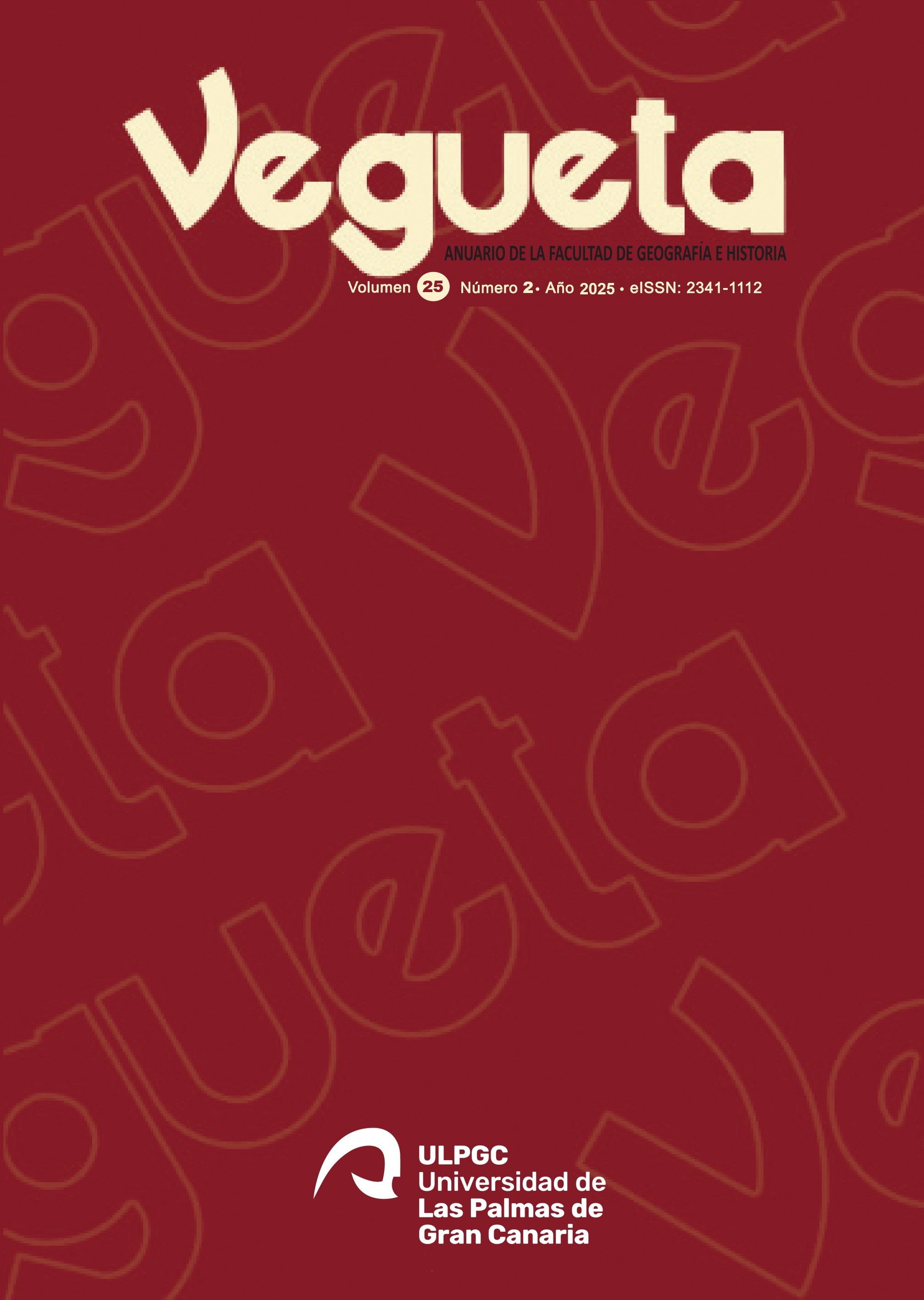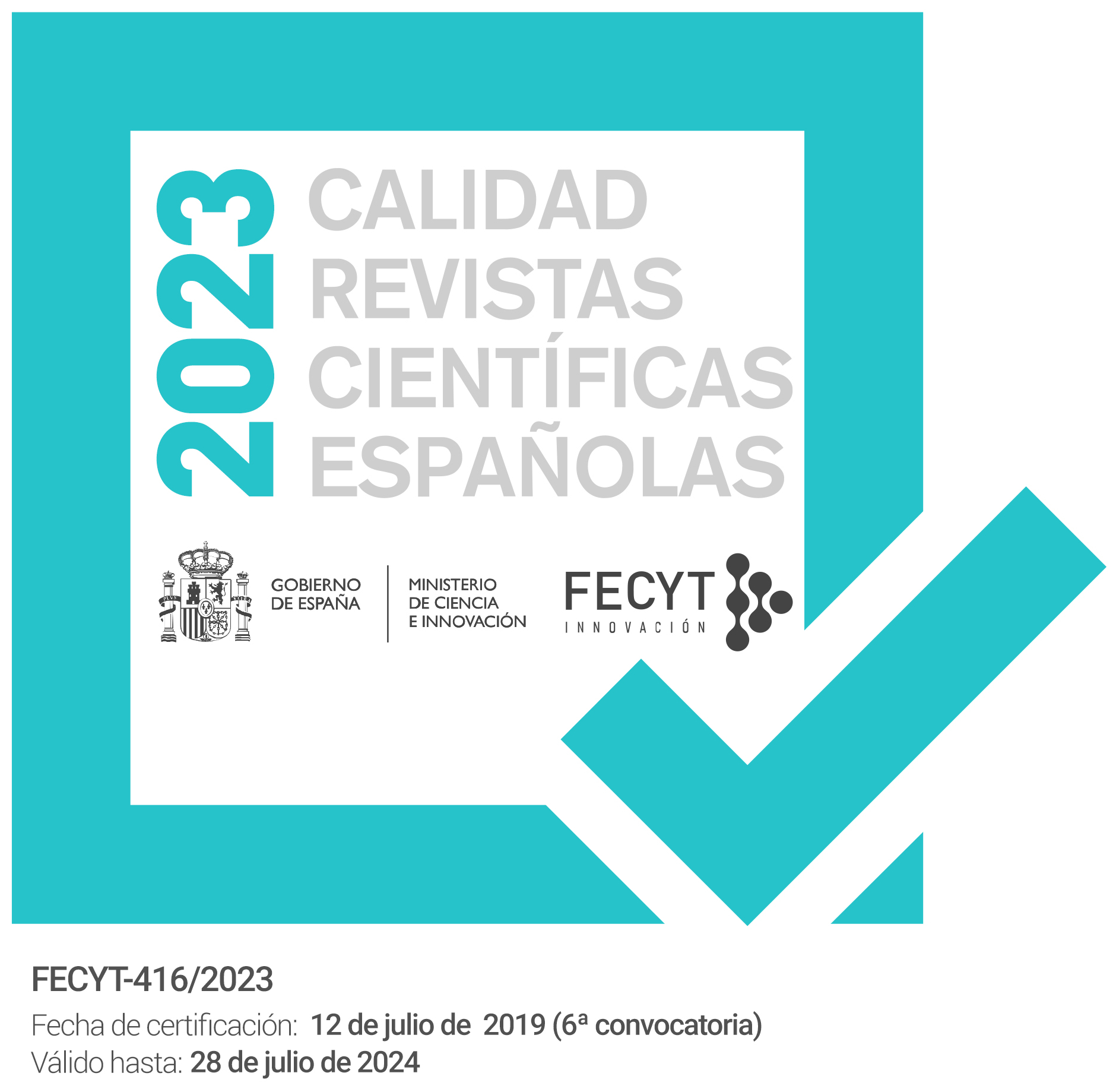El giro espacial para el grupo escultórico de Atenea y Marsias de Mirón. Hacia una propuesta parasemántica
DOI:
https://doi.org/10.51349/veg.2025.2.19Palabras clave:
giro espacial, Memory studies, exvotos, Atenas, MirónResumen
La revisión de los trabajos arqueológicos sobre la reconstrucción de la Acrópolis ateniense de mediados del siglo V a.C. pone en tela de juicio el discurso tradicional sobre la ubicación e interpretación del grupo escultórico de Atenea y Marsias de Mirón (450-440 a.C.). Junto al análisis formal e iconográfico del conjunto -anathema votivo-, la incorporación de la dimensión espacial ofrece una alternativa semántica estrechamente vinculada con los recientes Memory Studies. La comprensión del espacio que rodea al grupo y la interacción dinámica generada entre este y el observador revela una posible lectura identitaria étnica ateniense oculta tras el bronce mironiano.
Descargas
Citas
- Andrén, A. (1944): Der lateranische Silen und die Gruppe von Athena und Marsyas, Opuscula archaeologica, 3: 1-36.
- de Angelis, F. (1996): La battaglia di Maratona nella Stoa Poikile, ASNP, 4 (1): 119-171. https://www.jstor.org/stable/24308167
- Barker, A. (1984): Greek Musical Writings. I. The Musician and his Art, Cambridge University Press, Cambridge.
- Bellido-Pérez, E. (2021): La educación de la mirada: el mito de la Gigantomaquia en el arte como herramienta propagandística a lo largo de la historia, Educação & Linguagem, 24 (1): 289-304. doi: https://doi.org/10.15603/2176-1043/el.v24n1p289-304.
- Boardman, J. (1956): Some Attic Fragments: Pot, Plaque, and Dithyramb, The Journal of Hellenic Studies, 76: 18-25. doi: https://doi.org/10.2307/629550
- Caire, E. (2015): Jouer de l’aulos à Athènes était-il politiquement correct?, Pallas. Revue d’études antiques, 98: 57-72. doi: https://doi.org/10.4000/pallas.2650
- Castriota, D. (1992): Myth, Ethos, Actuality. Official Art in Fifth-Century B.C. Athens, The University of Wisconsin Press, Madison.
- Castriota, D. (2005): Feminizing the Barbarian and Barbarizing the Feminine. Amazons, Trojans and the Persians in the Stoa Poikile, en J. Barringer; J. Hurwit (eds.), Periklean Athens and Its Legacy. Problems and Perspectives, University of Texas Press, Austin: 89-102.
- Cerqueira, F. V. (2014): The presence of music in Greek worship. An iconographical approach, Chaos e Kosmos, 15: 1-40.
- Daltrop, G. (1980): Il gruppo mironiano di Atena e Marsia nei Musei Vaticani, Monumenti, Musei e Gallerie Pontifìcie, Ciudad del Vaticano.
- Daltrop, G.; Bol, P. C. (1983): Athena des Myron, Liebieghaus, Fráncfort del Meno.
- Davison, C. C. (2009): Pheidias. The Sculptures and Ancient Sources. Volume 1, University of London, Londres.
-Davison, J. A. (1958): Notes on the Panathenaea, The Journal of Hellenic Studies, 78: 23-42. doi: https://doi.org/10.2307/628920
- Domínguez, A. J.; Pascual, J. (1999): Esparta y Atenas en el siglo V a.C., Editorial Síntesis, Madrid.
- Elvira, M. A. (2019): Historia del arte griego. Obras y artistas de la antigua Grecia, Guillermo Escolar Editor, Madrid.
- Fehr, B. (2008): Bilderzählung und Handlungsmuster: Athena, Marsyas, der Aulos und die jungen Leute von Athen, en M. Seifert (ed.), Komplexe Bilder, Leonhard - Thurneysser-Verlag, Berlín - Basel; 129-149.
- la Follette, L. (1986): The Chalkotheke on the Athenian Akropolis, Hesperia, 55: 75-87. doi: https://doi.org/10.2307/147731
- Geominy, W. (2003): Athena und Marsyas – Eine frühklassische Gruppe in Raum und Zeit, en P. C. Bol (ed.), Zum Verhältnis von Raum und Zeit in der griechischen Kunst, Bibliopolis, Möhnesee: 143-160.
- von den Hoff, R. (2010): Theseus – Stadtgründer und Kulturheros, en E. Stein-Hölkeskamp; K. J. Hölkeskamp (eds.), Die griechische Welt. Erinnerungsorte der Antike, C. H. Beck., Múnich: 300-315.
- Hölscher, T. (1973): Griechische Historienbilder des 5. Und 4. Jahrhunderts v. Chr, Triltsch, Würzburg.
- Hölscher, T. (1998): Images and Political Identity: The Case of Athens, en D. Boedeker; K. Raaflaub, (eds.), Democracy, Empire, and the Arts in Fifth-Century Athens, Center for Hellenic Studies Colloquia, Cambridge: 153-183.
- Hölscher, T. (2015): Art, Architecture, and Spaces in Greek Participatory Communities, en D. Hammer (ed.), A Companion to Greek Democracy and the Roman Republic, Wiley-Blackwell, Oxford: 461-481.
- Hurwit, J. M. (1999): The Athenian Acropolis. History, Mythology, and Archaeology from the Neolithic Era to the Present, Cambridge University Press, Cambridge.
- Hurwit, J. M. (2004): The Acropolis in the age of Pericles, Cambridge University Press, Cambridge.
- Judeich, W. (1994) [1931]: Topographie von Athen, Ares Publishers, INC, Chicago.
- Junker, K. (2002): Die Athena-Marsyas-Gruppe des Myron, Jahrbuch des Deutschen Archaologischen Instituts, 117: 127-184.
- van Keer, E. (2004): The Myth of Marsyas in Ancient Greek Art: musical and mythological iconography, Music in Art, 29 (1-2): 20-37. https://ssrn.com/abstract=2263830
- Keesling, C. M. (2003): The votive statues of the Athenian Acropolis, Cambridge University Press, Cambridge.
- Keesling, C. M. (2020): Innovation and Deception: Athenian Commemoration of the Persian Wars, en M. Meyer; G. Adornato (eds.), Innovations and Inventions in Athens c. 530 to 470 BCE – Two Crucial Generations, Phoibos Verlag, Viena: 211-227.
- Kemp, J. A. (1966): Professional musicians in ancient Greece, Greece & Rome, 13 (2): 213-222. http://www.jstor.org/stable/642604
- Ludwig Preller, C. R. (1872): Griechische Mythologie, Weidmannsche Buchhandlung, Berlín.
- Meiggs, R. (1972): The Athenian Empire, Clarendon Press, Oxford.
- Moltesen, M. (1971): A new Replica of Myron's Athena, Analecta Romana. Instituto Danici, 6: 7-15.
- Müller, K. O. (1830): Handbuch der Archäologie der Kunst, Josef Max, Breslau.
-Newby, Z. (2016): Greek Myths in Roman Art and Culture. Imagery, Values and Identity in Italy, 50 BC–AD 250, Cambridge University Press, Cambridge.
- Nordquist, G. C. (1992): Instrumental Music in Representations of Greek Cult, en R. Hägg (ed.), The Iconography of Greek Cult in the Archaic and Classical Periods, Centre d’Étude de la Religion Grecque Antique, Atenas - Lieja: 143-168.
- van Oeveren, C. D. P. (1999): Bacchylides Ode 17: Theseus and the Delian League, en I. L. Pfeijffer; S. - R. Slings (eds.), One Hundred Years of Bacchylides, Proceedings of a Colloquim Held at the Vrije Universeieit Amsterdam, VU University Press, Amsterdam: 31-42.
- Pascual, J. (2001): Identidades y fronteras en Grecia central, en P. López; S. Reboreda (eds.), Fronteras e identidad en el mundo griego antiguo, Universidad de Santiago de Compostela - Universidad de Vigo, Santiago de Compostela - Vigo: 241-263.
- Picard, C. (1939): Manuel d'archéologie grecque: la sculpture, Tome 2, Vol. 1, Période Classique, Vè siècle, Auguste Picard, París.
- Pickard-Cambridge, A. (1968): The Dramatic Festivals of Athens, Clarendon Press, Oxford.
- Poehlmann, E. (2017): Aristotle on Music and Theatre (Politics VIII 6. 1340 b 20-1342b 34; Poetics), en A. Fountoulakis; A. Markantonatos; G. Vasilaros (eds.), Theatre World, Walter de Gruyter GmbH, Berlín - Boston: 317-345.
- Pollak, L. (1909): Die Athena der Marsyasgruppe Myrons, Jahreshefte des Österreichischen Archäologischen Institutes in Wien, 12: 154-165.
- Pollitt, J. J. (1972): Art and Experience in Classical Greece, Cambridge University Press, Cambridge.
- Proietti, G. (2015): Beyond the ‘Invention of Athens’. The 5th Century Athenian Tatenkatalog as Example of Intentional History, Klio, 97 (2): 1-23. doi: https://doi.org/10.1515/klio-2015-0036
- Proietti, G. (2020): I Greci e le Guerre Persiane. Memorie in competizione sulla scena panellenica, ὅρμος - Ricerche di Storia Antica, 12: 11-48. doi: https://dx.doi.org/10.7430/HORMOS1202
- Proietti, G. (2021): Prima di Erodoto. Aspetti della memoria delle Guerre Persiane, Franz Steiner Verlag, Stuttgart.
- Rawson, P. B. (1987): The Myth of Marsyas in the Roman Visual Arts. An Iconographic Study, B.A.R., Oxford.
- Robertson, M. (1975): A History of Greek Art I, Cambridge University Press, Londres.
- Roesch, P. (1989): L’Aulos et les aulètes en Béotie, en H. Beister; J. Buckler (eds.), Vorträge vom 5 Intenationalen Böotien Kolloquium, Editio Maris, Múnich: 203-214.
- Rung, E. (2013): Herodotus and Greek Medism, en A. Mehl; A. Makhlayuk; O. Gabelko (eds.), Ruthenia Classica Aetatis Novae: A collection of Works by Russian Scholars in Ancient Greek and Roman History, Franz Steiner Verlag, Stuttgart: 71-82.
- Sauer, B. (1908): Die Marsyasgruppe des Myron, Jahrbuch des Deutschen Archäologischen Instituts, 23: 125-162.
- Schröder, S. F. (2004): Catálogo de la escultura clásica del Museo del Prado. II. Escultura mitológica, Museo del Prado, Madrid.
- Seemann, L. (2009): Zur Interpretation der Athena-Marsyas-Gruppe des Myron, BOREAS. Münstersche Beiträge zur Archäologie, 32: 1-19.
- Shapiro, H. A. (1989): Art und Cult under the Tyrants in Athens, Von Zabern, Mainz.
- Simon, E. (1983): Festivals of Attica. An Archaeological Commentary, The University of Wisconsin Press, Madison.
- Stevens, G. (1936): The Periclean Entrance Court of the Acropolis of Athens, Hesperia, 5 (4): 443-520. doi: https://doi.org/10.2307/146607
- Svoronos, J. N. (1923-1926): Les monnaies d’Athènes, Bruckmann Éditeurs, Múnich.
- Todini, L. (2008): Παλαιά τε καὶ καινά. Erodoto e il ciclo figurativo della Stoà Poikile, Historia: Zeitschrift für Alte Geschichte, 57 (3): 255-262. https://www.jstor.org/stable/25598434
- Walker, H. J. (1995): Theseus and Athens, Oxford University Press, Nueva York - Oxford.
- Wallace, R. W. (2003): An Early Fifth-Century Athenian Revolution in Aulos Music, Harvard Studies in Classical Philology, 101: 73-92. doi: https://doi.org/10.2307/3658525
- Walter-Karydi, E. (2020): The Athenians discover themselves as a community and enhance their connection to the Polis and Theseus, en M. Meyer; G. Adornato (eds.), Innovations and Inventions in Athens c. 530 to 470 BCE – Two Crucial Generations, Phoibos Verlag, Viena: 99-111.
- Weis, A. (1979): The Marsyas of Myron: Old Problems and New Evidence, American Journal of Archaeology, 83 (2): 214-219. doi: https://doi.org/10.2307/504906
- West, M. L. (1992): Ancient Greek Music, Clarendon Press, Oxford.
- Wilamowitz-Moellendorff, U. (1973) [1931]: Der Glaube der Hellenen, Wissenschaftliche Buchgesellschaft, Darmstadt.
- Wilson, P. (1999): The aulos in Athens, en S. Goldhill; R. Osborne (eds.), Performance Culture and Athenian Democracy, Cambridge University Press, Cambridge: 58-95.
- Zaccarini, M. (2007): Cimone e la politica antipersiana. Una nuova lettura di un cratere del Pittore di Bologna 279 da Spina Valle Trebba, en F. Giudice; R. Panvini (eds.), Il greco, il barbaro e la ceramica attica. Immaginario del diverso, processi di scambio ed autorappresentazione degli indigeni, Quaderni della Scuola di Specializzazione in Archeologia dell'Università di Catania, Roma: 97-106.
- Zimmermann, B. (1992): Dithyrambos: Geschichte einer Gattung, Vandenhoeck & Ruprecht, Göttingen.
Descargas
Publicado
Número
Sección
Licencia
Derechos de autor 2025 Francisco Javier García Martín

Esta obra está bajo una licencia internacional Creative Commons Atribución-NoComercial-SinDerivadas 4.0.




